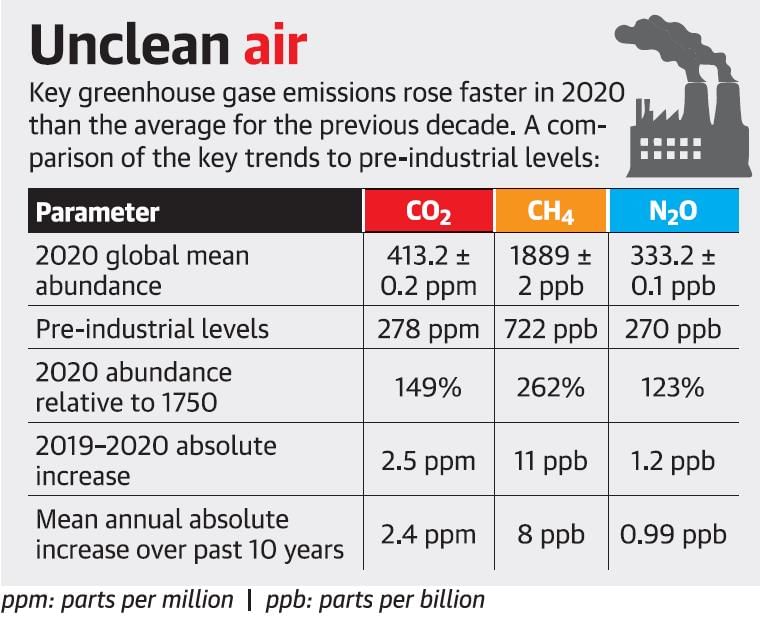Current Affairs Exam > Current Affairs Questions > With reference to the greenhouse gas emission...
Start Learning for Free
With reference to the greenhouse gas emissions in 2020, consider the following statements:
1. A report from the World Meteorological Organisation (WMO) said the increase in CO2 from 2019 to 2020 was slightly lower than that observed from 2018 to 2019 but higher than the average annual growth rate over the past decade.
2. The National Oceanic and Atmospheric Administration (NOAA) Annual Greenhouse Gas Index (AGGI) shows that from 1990 to 2020, radiative forcing by long-lived greenhouse gases (LLGHGs) increased by 47%.
Which of the statements given above is/are correct?
- a)1 only
- b)2 only
- c)Both 1 and 2
- d)Neither 1 nor 2
Correct answer is option 'C'. Can you explain this answer?
| FREE This question is part of | Download PDF Attempt this Test |
Verified Answer
With reference to the greenhouse gas emissions in 2020, consider the f...
A report from the World Meteorological Organisation (WMO) said the increase in CO2 from 2019 to 2020 was slightly lower than that observed from 2018 to 2019 but higher than the average annual growth rate over the past decade.
- This is despite the approximately 5.6% drop in fossil fuel CO2 emissions in 2020 due to restrictions related to the pandemic. The Bulletin, as the WMO report is called, shows that the pandemic disruption in 2020 didn’t significantly dent overall greenhouse gas emissions.
- For methane, the increase from 2019 to 2020 was higher than that observed from 2018 to 2019 and also higher than the average annual growth rate over the past decade.
- For nitrous oxides also, the increase was higher and also than the average annual growth rate over the past 10 years.
- The National Oceanic and Atmospheric Administration (NOAA) Annual Greenhouse Gas Index (AGGI) shows that from 1990 to 2020, radiative forcing by long-lived greenhouse gases (LLGHGs) increased by 47%, with CO2 accounting for about 80% of this increase.
- Concentration of carbon dioxide (CO2), the most significant greenhouse gas, reached 413.2 parts per million in 2020 and is 149% of the pre-industrial level. Methane (CH4) is 262% and nitrous oxide (N2O) is 123% of the levels in 1,750 when human activities started disrupting earth’s natural equilibrium.


|
Explore Courses for Current Affairs exam
|

|
Similar Current Affairs Doubts
With reference to the greenhouse gas emissions in 2020, consider the following statements:1. A report from the World Meteorological Organisation (WMO) said the increase in CO2 from 2019 to 2020 was slightly lower than that observed from 2018 to 2019 but higher than the average annual growth rate over the past decade.2. The National Oceanic and Atmospheric Administration (NOAA) Annual Greenhouse Gas Index (AGGI) shows that from 1990 to 2020, radiative forcing by long-lived greenhouse gases (LLGHGs) increased by 47%.Which of the statements given above is/are correct?a)1 onlyb)2 onlyc)Both 1 and 2d)Neither 1 nor 2Correct answer is option 'C'. Can you explain this answer?
Question Description
With reference to the greenhouse gas emissions in 2020, consider the following statements:1. A report from the World Meteorological Organisation (WMO) said the increase in CO2 from 2019 to 2020 was slightly lower than that observed from 2018 to 2019 but higher than the average annual growth rate over the past decade.2. The National Oceanic and Atmospheric Administration (NOAA) Annual Greenhouse Gas Index (AGGI) shows that from 1990 to 2020, radiative forcing by long-lived greenhouse gases (LLGHGs) increased by 47%.Which of the statements given above is/are correct?a)1 onlyb)2 onlyc)Both 1 and 2d)Neither 1 nor 2Correct answer is option 'C'. Can you explain this answer? for Current Affairs 2024 is part of Current Affairs preparation. The Question and answers have been prepared according to the Current Affairs exam syllabus. Information about With reference to the greenhouse gas emissions in 2020, consider the following statements:1. A report from the World Meteorological Organisation (WMO) said the increase in CO2 from 2019 to 2020 was slightly lower than that observed from 2018 to 2019 but higher than the average annual growth rate over the past decade.2. The National Oceanic and Atmospheric Administration (NOAA) Annual Greenhouse Gas Index (AGGI) shows that from 1990 to 2020, radiative forcing by long-lived greenhouse gases (LLGHGs) increased by 47%.Which of the statements given above is/are correct?a)1 onlyb)2 onlyc)Both 1 and 2d)Neither 1 nor 2Correct answer is option 'C'. Can you explain this answer? covers all topics & solutions for Current Affairs 2024 Exam. Find important definitions, questions, meanings, examples, exercises and tests below for With reference to the greenhouse gas emissions in 2020, consider the following statements:1. A report from the World Meteorological Organisation (WMO) said the increase in CO2 from 2019 to 2020 was slightly lower than that observed from 2018 to 2019 but higher than the average annual growth rate over the past decade.2. The National Oceanic and Atmospheric Administration (NOAA) Annual Greenhouse Gas Index (AGGI) shows that from 1990 to 2020, radiative forcing by long-lived greenhouse gases (LLGHGs) increased by 47%.Which of the statements given above is/are correct?a)1 onlyb)2 onlyc)Both 1 and 2d)Neither 1 nor 2Correct answer is option 'C'. Can you explain this answer?.
With reference to the greenhouse gas emissions in 2020, consider the following statements:1. A report from the World Meteorological Organisation (WMO) said the increase in CO2 from 2019 to 2020 was slightly lower than that observed from 2018 to 2019 but higher than the average annual growth rate over the past decade.2. The National Oceanic and Atmospheric Administration (NOAA) Annual Greenhouse Gas Index (AGGI) shows that from 1990 to 2020, radiative forcing by long-lived greenhouse gases (LLGHGs) increased by 47%.Which of the statements given above is/are correct?a)1 onlyb)2 onlyc)Both 1 and 2d)Neither 1 nor 2Correct answer is option 'C'. Can you explain this answer? for Current Affairs 2024 is part of Current Affairs preparation. The Question and answers have been prepared according to the Current Affairs exam syllabus. Information about With reference to the greenhouse gas emissions in 2020, consider the following statements:1. A report from the World Meteorological Organisation (WMO) said the increase in CO2 from 2019 to 2020 was slightly lower than that observed from 2018 to 2019 but higher than the average annual growth rate over the past decade.2. The National Oceanic and Atmospheric Administration (NOAA) Annual Greenhouse Gas Index (AGGI) shows that from 1990 to 2020, radiative forcing by long-lived greenhouse gases (LLGHGs) increased by 47%.Which of the statements given above is/are correct?a)1 onlyb)2 onlyc)Both 1 and 2d)Neither 1 nor 2Correct answer is option 'C'. Can you explain this answer? covers all topics & solutions for Current Affairs 2024 Exam. Find important definitions, questions, meanings, examples, exercises and tests below for With reference to the greenhouse gas emissions in 2020, consider the following statements:1. A report from the World Meteorological Organisation (WMO) said the increase in CO2 from 2019 to 2020 was slightly lower than that observed from 2018 to 2019 but higher than the average annual growth rate over the past decade.2. The National Oceanic and Atmospheric Administration (NOAA) Annual Greenhouse Gas Index (AGGI) shows that from 1990 to 2020, radiative forcing by long-lived greenhouse gases (LLGHGs) increased by 47%.Which of the statements given above is/are correct?a)1 onlyb)2 onlyc)Both 1 and 2d)Neither 1 nor 2Correct answer is option 'C'. Can you explain this answer?.
Solutions for With reference to the greenhouse gas emissions in 2020, consider the following statements:1. A report from the World Meteorological Organisation (WMO) said the increase in CO2 from 2019 to 2020 was slightly lower than that observed from 2018 to 2019 but higher than the average annual growth rate over the past decade.2. The National Oceanic and Atmospheric Administration (NOAA) Annual Greenhouse Gas Index (AGGI) shows that from 1990 to 2020, radiative forcing by long-lived greenhouse gases (LLGHGs) increased by 47%.Which of the statements given above is/are correct?a)1 onlyb)2 onlyc)Both 1 and 2d)Neither 1 nor 2Correct answer is option 'C'. Can you explain this answer? in English & in Hindi are available as part of our courses for Current Affairs.
Download more important topics, notes, lectures and mock test series for Current Affairs Exam by signing up for free.
Here you can find the meaning of With reference to the greenhouse gas emissions in 2020, consider the following statements:1. A report from the World Meteorological Organisation (WMO) said the increase in CO2 from 2019 to 2020 was slightly lower than that observed from 2018 to 2019 but higher than the average annual growth rate over the past decade.2. The National Oceanic and Atmospheric Administration (NOAA) Annual Greenhouse Gas Index (AGGI) shows that from 1990 to 2020, radiative forcing by long-lived greenhouse gases (LLGHGs) increased by 47%.Which of the statements given above is/are correct?a)1 onlyb)2 onlyc)Both 1 and 2d)Neither 1 nor 2Correct answer is option 'C'. Can you explain this answer? defined & explained in the simplest way possible. Besides giving the explanation of
With reference to the greenhouse gas emissions in 2020, consider the following statements:1. A report from the World Meteorological Organisation (WMO) said the increase in CO2 from 2019 to 2020 was slightly lower than that observed from 2018 to 2019 but higher than the average annual growth rate over the past decade.2. The National Oceanic and Atmospheric Administration (NOAA) Annual Greenhouse Gas Index (AGGI) shows that from 1990 to 2020, radiative forcing by long-lived greenhouse gases (LLGHGs) increased by 47%.Which of the statements given above is/are correct?a)1 onlyb)2 onlyc)Both 1 and 2d)Neither 1 nor 2Correct answer is option 'C'. Can you explain this answer?, a detailed solution for With reference to the greenhouse gas emissions in 2020, consider the following statements:1. A report from the World Meteorological Organisation (WMO) said the increase in CO2 from 2019 to 2020 was slightly lower than that observed from 2018 to 2019 but higher than the average annual growth rate over the past decade.2. The National Oceanic and Atmospheric Administration (NOAA) Annual Greenhouse Gas Index (AGGI) shows that from 1990 to 2020, radiative forcing by long-lived greenhouse gases (LLGHGs) increased by 47%.Which of the statements given above is/are correct?a)1 onlyb)2 onlyc)Both 1 and 2d)Neither 1 nor 2Correct answer is option 'C'. Can you explain this answer? has been provided alongside types of With reference to the greenhouse gas emissions in 2020, consider the following statements:1. A report from the World Meteorological Organisation (WMO) said the increase in CO2 from 2019 to 2020 was slightly lower than that observed from 2018 to 2019 but higher than the average annual growth rate over the past decade.2. The National Oceanic and Atmospheric Administration (NOAA) Annual Greenhouse Gas Index (AGGI) shows that from 1990 to 2020, radiative forcing by long-lived greenhouse gases (LLGHGs) increased by 47%.Which of the statements given above is/are correct?a)1 onlyb)2 onlyc)Both 1 and 2d)Neither 1 nor 2Correct answer is option 'C'. Can you explain this answer? theory, EduRev gives you an
ample number of questions to practice With reference to the greenhouse gas emissions in 2020, consider the following statements:1. A report from the World Meteorological Organisation (WMO) said the increase in CO2 from 2019 to 2020 was slightly lower than that observed from 2018 to 2019 but higher than the average annual growth rate over the past decade.2. The National Oceanic and Atmospheric Administration (NOAA) Annual Greenhouse Gas Index (AGGI) shows that from 1990 to 2020, radiative forcing by long-lived greenhouse gases (LLGHGs) increased by 47%.Which of the statements given above is/are correct?a)1 onlyb)2 onlyc)Both 1 and 2d)Neither 1 nor 2Correct answer is option 'C'. Can you explain this answer? tests, examples and also practice Current Affairs tests.

|
Explore Courses for Current Affairs exam
|

|
Suggested Free Tests
Signup for Free!
Signup to see your scores go up within 7 days! Learn & Practice with 1000+ FREE Notes, Videos & Tests.























